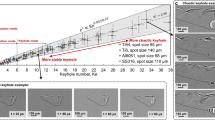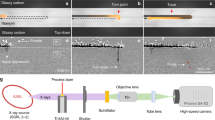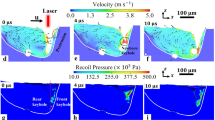Abstract
Metal three-dimensional (3D) printing involves a multitude of operational and material parameters that exhibit intricate interdependencies, which pose challenges to real-time process optimization, monitoring, and controlling. The dynamic behavior of the laser-induced melt pool strongly influences the final printed part quality by controlling the absorption of laser power and impacting defect creation, porosity, and surface finish. By leveraging ultrahigh-speed synchrotron X-ray imaging and high-fidelity multiphysics modeling, we identify correlations between laser process parameters, keyhole and melt pool morphologies, laser absorptance, and porosity in metal 3D printing of Ti-6Al-4V, aiding in the development of effective printing strategies. Our models accurately predict the geometries and shapes of melt pools and keyholes, laser absorptance, and the size and shape of keyhole-induced pores during the additive manufacturing processes using different laser parameters, for both bare and powder cases. This work establishes robust correlations among process parameters, melt pool and keyhole morphology, and materials properties. These findings provide valuable insights into the complex interplay among different design factors in metal 3D printing, laying a strong foundation for the development of highly effective and efficient additive manufacturing processes.













Similar content being viewed by others
Data availability
All the required data that support the findings of this study are available in this paper. Some of the data are available in the NIST Public Data Repository [44].
References
Martin JH, Yahata BD, Hundley JM, Mayer JA, Schaedler TA, Pollock TM (2017) 3D printing of high-strength aluminium alloys. Nature 549(7672):365–369
Buhairi MA, Foudzi FM, Jamhari FI, Sulong A, Radzuan NAM, Muhamad N, Mohamed IF, Azman AH, Harun WSW, Al-Furjan MSH (2023) Review on volumetric energy density: influence on morphology and mechanical properties of Ti6Al4V manufactured via laser powder bed fusion. Prog Addit Manufact 8(2):265–283
Ferreira BT, Alves A, de Campos R, Casati AG, Leite M, Ribeiro I (2023) Technological capabilities and sustainability aspects of metal additive manufacturing. Prog Addit Manufact. https://doi.org/10.1007/s40964-023-00534-4
Priarone PC, Catalano AR, Settineri L (2023) Additive manufacturing for the automotive industry: on the life-cycle environmental implications of material substitution and lightweighting through re-design. Prog Addit Manufact 8(6):1229–1240. https://doi.org/10.1007/s40964-023-00395-x
Cunningham R, Zhao C, Parab N, Kantzos C, Pauza J, Fezzaa K, Sun T, Rollett AD (2019) Keyhole threshold and morphology in laser melting revealed by ultrahigh-speed X-ray imaging. Science 363(6429):849–852
Ren Z, Gao L, Clark SJ, Fezzaa K, Shevchenko P, Choi A, Everhart W, Rollett AD, Chen L, Sun T (2023) Machine learning–aided real-time detection of keyhole pore generation in laser powder bed fusion. Science 379(6627):89–94
Huang Y, Fleming TG, Clark SJ, Marussi S, Fezzaa K, Thiyagalingam J, Leung CLA, Lee PD (2022) Keyhole fluctuation and pore formation mechanisms during laser powder bed fusion additive manufacturing. Nat Commun 13(1):1170
Cacace S, Pagani L, Colosimo BM, Semeraro Q (2022) The effect of energy density and porosity structure on tensile properties of 316L stainless steel produced by laser powder bed fusion. Prog Addit Manufact 7(5):1053–1070
Ning J, Sievers DE, Garmestani H, Liang SY (2020) Analytical modeling of part porosity in metal additive manufacturing. Int J Mech Sci 172:105428
Leung CLA, Marussi S, Atwood RC, Towrie M, Withers PJ, Lee PD (2018) In situ X-ray imaging of defect and molten pool dynamics in laser additive manufacturing. Nat Commun 9(1):1355
Fayazfar H, Salarian M, Rogalsky A, Sarker D, Russo P, Paserin V, Toyserkani E (2018) A critical review of powder-based additive manufacturing of ferrous alloys: Process parameters, microstructure and mechanical properties. Mater Des 144:98–128
Bisht M, Ray N, Verbist F, Coeck S (2018) Correlation of selective laser melting-melt pool events with the tensile properties of Ti-6Al-4V ELI processed by laser powder bed fusion. Addit Manuf 22:302–306
Martin AA, Calta NP, Khairallah SA, Wang J, Depond PJ, Fong AY, Thampy V, Guss GM, Kiss AM, Stone KH (2019) Dynamics of pore formation during laser powder bed fusion additive manufacturing. Nat Commun 10(1):1987
Bitharas I, Parab N, Zhao C, Sun T, Rollett A, Moore A (2022) The interplay between vapour, liquid, and solid phases in laser powder bed fusion. Nat Commun 13(1):2959
Ertürk E, Musil B, Diez G, Felber C, Höfer P (2023) Surface morphology influences of PBF-LB manufactured Ti6Al4V parts on adhesive bond strength—investigation of as-built and surface-treated conditions. Prog Addit Manufact 8(4):719–731. https://doi.org/10.1007/s40964-023-00450-7
Buffa G, Palmeri D, Pollara G, Franco FD, Santamaria M, Fratini L (2022) Process parameters and surface treatment effects on the mechanical and corrosion resistance properties of Ti6Al4v aeronautical components produced by laser powder bed fusion. SSRN Electron J. https://doi.org/10.2139/ssrn.4102474
Queva A, Guillemot G, Moriconi C, Metton C, Bellet M (2020) Numerical study of the impact of vaporisation on melt pool dynamics in Laser Powder Bed Fusion-Application to IN718 and Ti–6Al–4V. Addit Manuf 35:101249
Shi R, Khairallah S, Heo TW, Rolchigo M, McKeown JT, Matthews MJ (2019) Integrated simulation framework for additively manufactured Ti-6Al-4V: melt pool dynamics, microstructure, solid-state phase transformation, and microelastic response. Jom 71:3640–3655
Tseng C-C, Li C-J (2019) Numerical investigation of interfacial dynamics for the melt pool of Ti-6Al-4V powders under a selective laser. Int J Heat Mass Transf 134:906–919
Ge W, Fuh JY, Na SJ (2021) Numerical modelling of keyhole formation in selective laser melting of Ti6Al4V. J Manuf Process 62:646–654
Promoppatum P, Srinivasan R, Quek SS, Msolli S, Shukla S, Johan NS, van der Veen S, Jhon MH (2022) Quantification and prediction of lack-of-fusion porosity in the high porosity regime during laser powder bed fusion of Ti-6Al-4V. J Mater Process Technol 300:117426
Khairallah SA, Anderson AT, Rubenchik A, King WE (2016) Laser powder-bed fusion additive manufacturing: Physics of complex melt flow and formation mechanisms of pores, spatter, and denudation zones. Acta Mater 108:36–45
Khairallah SA, Martin AA, Lee JR, Guss G, Calta NP, Hammons JA, Nielsen MH, Chaput K, Schwalbach E, Shah MN (2020) Controlling interdependent meso-nanosecond dynamics and defect generation in metal 3D printing. Science 368(6491):660–665
Zhao C, Guo Q, Li X, Parab N, Fezzaa K, Tan W, Chen L, Sun T (2019) Bulk-explosion-induced metal spattering during laser processing. Phys Rev X 9(2):021052
Wang L, Zhang Y, Yan W (2020) Evaporation model for keyhole dynamics during additive manufacturing of metal. Phys Rev Appl 14(6):064039
Wang L, Zhang Y, Chia HY, Yan W (2022) Mechanism of keyhole pore formation in metal additive manufacturing. npj Comput Mater. https://doi.org/10.1038/s41524-022-00699-6
Bayat M, Thanki A, Mohanty S, Witvrouw A, Yang S, Thorborg J, Tiedje NS, Hattel JH (2019) Keyhole-induced porosities in Laser-based Powder Bed Fusion (L-PBF) of Ti6Al4V: High-fidelity modelling and experimental validation. Addit Manuf 30:100835
Tang C, Tan JL, Wong CH (2018) A numerical investigation on the physical mechanisms of single track defects in selective laser melting. Int J Heat Mass Transf 126:957–968
Tan P, Kiran R, Zhou K (2021) Effects of sub-atmospheric pressure on keyhole dynamics and porosity in products fabricated by selective laser melting. J Manuf Process 64:816–827
Lin R, Wang H-P, Lu F, Solomon J, Carlson BE (2017) Numerical study of keyhole dynamics and keyhole-induced porosity formation in remote laser welding of Al alloys. Int J Heat Mass Transf 108:244–256
Steen WM, Mazumder J (2010) Laser material processing. Springer Science & Business Media.
Cook PS, Ritchie DJ (2023) Determining the laser absorptivity of Ti-6Al-4V during laser powder bed fusion by calibrated melt pool simulation. Opt Laser Technol 162:109247
CIE, CIE DIS 017/E: 2016 ILV: International Lighting Vocabulary, CIE Vienna, 2016.
Simonds BJ, Tanner J, Artusio-Glimpse A, Williams PA, Parab N, Zhao C, Sun T (2021) The causal relationship between melt pool geometry and energy absorption measured in real time during laser-based manufacturing. Appl Mater Today 23:101049
Certain commercial equipment, software, and/or materials are identified in this paper in order to adequately specify the experimental procedure. In no case does such identification imply recommendation or endorsement by the National Institute of Standards.
Simonds BJ, Sowards J, Hadler J, Pfeif E, Wilthan B, Tanner J, Harris C, Williams P, Lehman J (2018) Time-resolved absorptance and melt pool dynamics during intense laser irradiation of a metal. Phys Rev Appl 10(4):044061
Simonds BJ, Tanner J, Artusio-Glimpse A, Williams PA, Parab N, Zhao C, Sun T (2020) Simultaneous high-speed X-ray transmission imaging and absolute dynamic absorptance measurements during high-power laser-metal processing. Proc CIRP 94:775–779
Simonds BJ, Garboczi EJ, Palmer TA, Williams PA (2020) Dynamic laser absorptance measured in a geometrically characterized stainless-steel powder layer. Phys Rev Appl 13(2):024057
Samaei A, Sang Z, Glerum JA, Mogonye J-E, Wagner GJ (2023) Multiphysics modeling of mixing and material transport in additive manufacturing with multicomponent powder beds. Addit Manuf 67:103481
Kozeny J (1927) Ueber kapillare leitung des wassers im boden. Sitzungsberichte der Akademie der Wissenschaften in Wien 136:271
Carman PC (1937) Fluid flow through a granular bed. Trans Inst Chem Eng London 15:150–156
Cho J-H, Na S-J (2006) Implementation of real-time multiple reflection and Fresnel absorption of laser beam in keyhole. J Phys D Appl Phys 39(24):5372
Liu B, Fang G, Lei L, Liu W (2020) A new ray tracing heat source model for mesoscale CFD simulation of selective laser melting (SLM). Appl Math Model 79:506–520
Simonds BJ, Tanner J, Artusio-Glimpse A, Williams PA, Parab N, Zhao C, Sun T (2022) Asynchronous AM Bench 2022 Challenge Data: Real-time, simultaneous absorptance and high-speed Xray imaging.
Babu BS, Srikanth V, Balram Y, Vishnuvardhan T, Baig MAA (2019) Numerical analysis on the indentation behavior of Ti-6Al-4V alloy. Mater Today: Proc 19:827–830
Zhang Y, Bai S, Riede M, Garratt E, Roch A (2020) A comprehensive study on fused filament fabrication of Ti-6Al-4V structures. Addit Manuf 34:101256
Li JJZ, Johnson WL, Rhim W-K (2006) Thermal expansion of liquid Ti-6Al-4V measured by electrostatic levitation. Appl Phys Lett. https://doi.org/10.1063/1.2349840
Boivineau M, Cagran C, Doytier D, Eyraud V, Nadal M-H, Wilthan B, Pottlacher G (2006) Thermophysical properties of solid and liquid Ti-6Al-4V (TA6V) alloy. Int J Thermophys 27:507–529
Mohr M, Wunderlich R, Novakovic R, Ricci E, Fecht H-J (2020) Precise measurements of thermophysical properties of liquid Ti–6Al–4V (Ti64) alloy on board the international space station. Adv Eng Mater 22(7):2000169
I. Flow Science, Santa Fe, NM, USA., FLOW-3D® Version 2023R1 Users Manual, (2023).
Khairallah SA, Sun T, Simonds BJ (2021) Onset of periodic oscillations as a precursor of a transition to pore-generating turbulence in laser melting. Addit Manufact Lett 1:100002
Mayi YA, Dal M, Peyre P, Bellet M, Fabbro R (2023) Physical mechanisms of conduction-to-keyhole transition in laser welding and additive manufacturing processes. Opt Laser Technol 158:108811
Xie X, Samaei A, Guo J, Liu WK, Gan Z (2022) Data-driven discovery of dimensionless numbers and governing laws from scarce measurements. Nat Commun 13(1):7562
Gan Z, Kafka OL, Parab N, Zhao C, Fang L, Heinonen O, Sun T, Liu WK (2021) Universal scaling laws of keyhole stability and porosity in 3D printing of metals. Nat Commun 12(1):2379
Ye J, Khairallah SA, Rubenchik AM, Crumb MF, Guss G, Belak J, Matthews MJ (2019) Energy coupling mechanisms and scaling behavior associated with laser powder bed fusion additive manufacturing. Adv Eng Mater 21(7):1900185
Author information
Authors and Affiliations
Corresponding author
Ethics declarations
Conflicts of interest
The authors declare that they have no known competing financial interests or personal relationships that could have appeared to influence the work reported in this paper.
Additional information
Publisher's Note
Springer Nature remains neutral with regard to jurisdictional claims in published maps and institutional affiliations.
Supplementary Information
Below is the link to the electronic supplementary material.
Supplementary file3 (AVI 12352 KB)
Supplementary file4 (AVI 7437 KB)
Supplementary file5 (AVI 12352 KB)
Supplementary file6 (AVI 7437 KB)
Rights and permissions
Springer Nature or its licensor (e.g. a society or other partner) holds exclusive rights to this article under a publishing agreement with the author(s) or other rightsholder(s); author self-archiving of the accepted manuscript version of this article is solely governed by the terms of such publishing agreement and applicable law.
About this article
Cite this article
Samaei, A., Leonor, J.P., Gan, Z. et al. Benchmark study of melt pool and keyhole dynamics, laser absorptance, and porosity in additive manufacturing of Ti-6Al-4V. Prog Addit Manuf (2024). https://doi.org/10.1007/s40964-024-00637-6
Received:
Accepted:
Published:
DOI: https://doi.org/10.1007/s40964-024-00637-6




